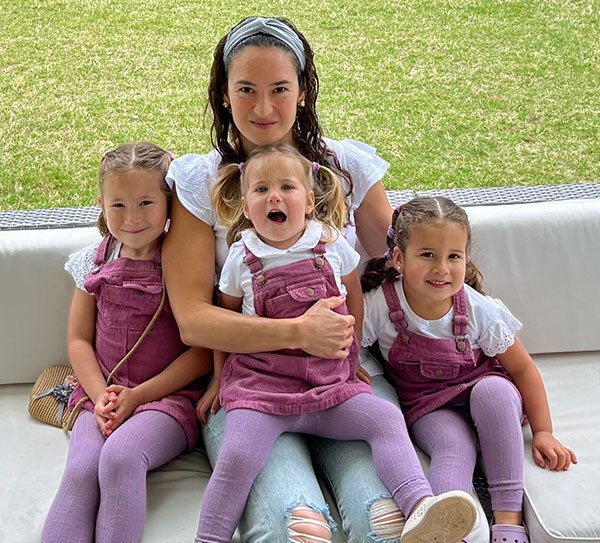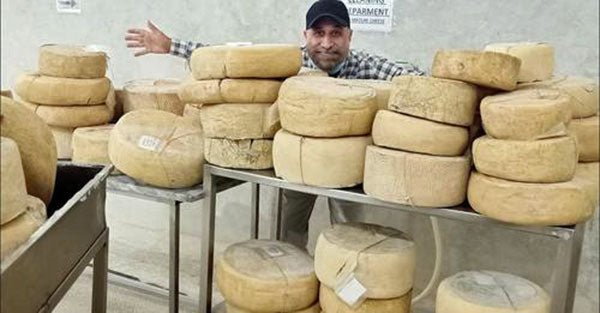Hilda loves to cook with natural/minimal ingredients so cheesemaking is a perfect fit. She has 3 adorable girls under the age of 6 and she is teaching them how to make the cheeses she grew up with in Venezuela. We think they’re very lucky to be getting this early start from their talented mother.
Hilda’s Story
When I was 14, my dad accepted a job offer out of the country in Panama, before Chavez would take office in Venezuela. It was a great decision since the country, unfortunately, has deteriorated since.
Then we moved to Colombia and then Mexico where I majored in college in industrial design.
After college, I moved to Miami, FL to earn my masters degree in fine arts graphic design. I lived in Miami for about 7 years, then I met my husband (from Spain) in New Hampshire at my brother’s MBA graduation. They were best friends.
We married, lived 1 year in Boston, MA and then moved to South Korea for 2 years, where we had our first daughter. (My husband used to work for Samsung Electronics at the time). It was an amazing experience living in Asia and, by the way, imported cheese was so expensive!
Then my husband found a different job in Atlanta, GA (we wanted to settle down somewhere in the south of the US). My two other daughters were born and we’ve been here in The Peach State since 2018!
I grew up eating fresh cheese every single day. It is a staple food of Venezuelan culture. We have many kinds of fresh, white cheeses (like Queso Blanco) – firm, semi-firm, soft, semi-soft, with eyes, and even aged white cheese that is cured with butter, coffee, salt and pepper.

This cheese (Queso Blanco) is pressed for 4 hours then left at room temperature or refrigerated. It is a very versatile white cheese. I use it grated on baked plantains, scrambled eggs, arepas, salads, ground beef and black beans, diced on soups, and fresh with figs or dates, etc. I also grill it in a pan or on a barbecue grill!
We eat these fresh cheeses with arepas (made of corn) that can be filled with ham or meat or eggs or avocado or beans – basically anything that comes to mind. We eat tequeños (fresh cheese filled sticks), cheese with pasta, bread, empanadas, cachapas (corn pancakes), etc.
I remember the taste of coffee and fresh cheese in the morning, and this is something I am teaching my girls at home.
It is very typical in Venezuela to buy fresh cheese from a cheese guy who comes in his truck once or twice a week. They still do this! So, I remember going with my grandma to pick up some cheese across the street. You cannot get fresher than that!
When I moved out of the country the first time, I missed our fresh cheese so much, and even though you can find similar ones in the US or Latin America now, they actually do not taste the same.
It is true that cheese is impacted by the environment, the source of the milk, what the cows were fed, bacterial community, temperature, etc. but I was always intrigued by why they would taste so different, even when they have the same ingredients.
I have always been picky about cheese ingredients – I don’t like preservatives and additives or shortcuts. I’ve always made things from scratch. I like to be in control of the ingredient list and when you make things yourself, it can really taste better. So, I didn’t see any reason why I shouldn’t try to make cheese as well.
I had The Art Of Natural Cheesemaking on my wish list (forever) and finally got it as a present last Christmas. I couldn’t stop reading it!
I couldn’t even finish it before starting my first batch of cheese! I really love his methods for making cheese.
And this is when I tried making my first cheese – “Dream Cheese” from the book, but I made it mixing Greek yogurt and kefir, since I’ve been making kefir for the last 2 and half years and aging the cheese balls in extra virgin olive oil in the fridge. So good!

This one and the ones below show my first cheese (“Dream Cheese”) made from Greek yogurt and kefir and aged in a jar with extra virgin olive oil for 4 weeks.
Then, I tried making the basic rennet cheese, paneer (from India), halloumi, mozzarella, feta, drunken wine cheese, Belper Knolle and, of course, ricotta with leftover whey.
Belper Knolle

Phase 2 Belper Knolle. Adding garlic and salt paste, covering in Italian species, ground coffee or toasted black pepper.
Ricotta
I add ricotta to soups, spinach, ground meat casserole, and eggs, and I mix it with roasted garlic, rosemary and olive oil for a delicious dip.
I have not tried the washed rind cheeses yet, and I am still waiting for my husband to make my cheese press. He loves working with wood so he wants to make it for me (haha!).
I make cheese every week, sometimes twice a week, but I am mostly making the fresh cheeses which are the ones I miss the most. My girls love it, and I use minimal ingredients – raw milk, raw kefir or old whey as a starter, rennet and salt.
I have made all kinds of Venezuelan cheeses, and I am SO happy with the flavors I have achieved! I would say they taste the same, or at least the closest in taste I have ever had outside of Venezuela.
In Venezuela, they use “old whey” as a starter. That means they use leftover whey from making cheese.
You leave it at room temperature to ferment for a few days, and then use it in your next batch of cheese (a small amount, depending on the recipe).
Old whey can last months in the fridge. This makes a big difference in the flavors developed!
I have been learning a lot from the Venezuelan cheese master, Professor Wilson Aguilar, and you have to check out his cheeses on his Instagram account- https://www.instagram.com/millano2021

Cheese expert Wilson making a type of mozzarella at his Instagram page.
He makes a kind of mozzarella cheese, very typical in Venezuela, called Queso de Mano (Hand Cheese), Telita, Guayanes, and Trenza (similar to Mexican Queso Oaxaca).

The fresh cheese curds need to get to a very specific pH to be able to become this elastic when heated. Wilson makes this cheese for a living, and has been doing it for more than 23 years (the traditional way).

My “Telita” version, similar to mozzarella. It was divine, but to be honest, I need to keep practicing this technique!!
Another Venezuelan cheese I make is called Palmita (also called Palmizulia). It is a semi-soft, fresh cheese with holes, which develop in warm and humid weather.
Some people make it in incubators, controlling the temperature and humidity. I have made mine in the garage (works in summer). I just keep it in the mold with the follower and pour some whey on top to keep it humid. It still drains whey through the mold holes.
1-2 days later, bacteria produces gas (CO2 bubbles), it inflates and develops all these holes and the aroma distinctive of this Venezuelan cheese.
All of my fresh cheeses are made the traditional way, with raw milk.
Other Venezuelans known out there, who I have been learning a lot from as well are Zorana (who you already interviewed https://cheesemaking.com/blogs/fun-along-the-whey/zorana-marquez-in-humble-texas), MiQuerencia, Erbuche, Jose Lorenzo, Javier Sosa, Daniel Avellaneda among others. But once you understand the concept, you get creative and start experimenting.
I am currently a home cheese maker, not planning to sell soon but I have been giving it away to friends and family. Let’s see where this takes me! I’m very excited to be able to make cheese, but raw milk is expensive and not sold for human consumption in many states.
In case you want to take a look, I created my brand (not registered yet) and have a social media account I started recently to share some of my cheeses – https://www.instagram.com/laquesuaartesanal
I have thought of selling my cheese but I would need to pasteurize the milk and so on, and I’m enjoying the traditional methods (with raw milk) from my country right now.
My brand is La Quesua Artesanal. “Quesua” is slang in Venezuela, and it comes from the word “queso” (cheese). It has a funny connotation, but that’s another story for another interview, LOL…





































































































































































